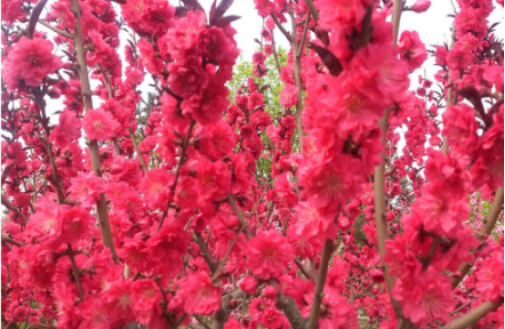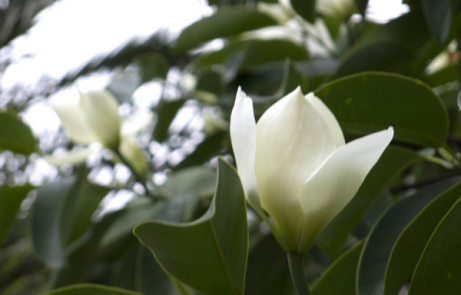Matters needing attention in the maintenance of Bi Peach Blossom
The maintenance of green peach blossoms is simpler than that of other ornamental flowers and trees. The main matters of maintenance are as follows:
1. Flowerpots and soil
Potted green peach should choose the right amount of flowerpots, not too large or too small, the soil is rich in humic substances, good drainage of sandy soil, before filling, you can put a small amount of bone powder or tellurium tablets as base fertilizer.
2. Fertilizing and watering
During the growing period, the peach should be fertilized according to the growth of the peach plant, usually only once before flowering in spring and once before falling leaves in autumn. Watering should be moderate, adequate watering should be done during summer high temperature and drought, and the rainy season should avoid stagnant water in tree pits and timely drainage so as not to cause tree roots to rot and die.
3. Pruning
The peach should be pruned in time after flowering, leaving only two to three buds at the base of the flowering peach branches, all the others are cut off, and the thin branches that are too dense are removed. When new branches grow to an appropriate height in summer, coring should be carried out to promote flower bud growth. In the northern region, the Spring Equinox can turn the basin and change the soil once every year, and the overdense roots can be trimmed appropriately when changing the basin.
4. Temperature
Although Bitao is more hardy, it is best to spend the winter in a cold room. Three to five days before the Spring Festival, the potted plant is moved indoors to keep the temperature rising slowly. In an environment of 20 to 25 degrees, Bitao will slowly civilize.

I believe that after reading the above introduction, friends also have an understanding of the reproduction of peach blossoms, which will certainly greatly improve the survival rate when maintaining and breeding peach blossoms. Thank you for your reading!
Potted peach blossom family conservation technology Bitao is a small deciduous tree of Rosaceae and Prunus. The double petal types that usually belong to ornamental peach blossoms are collectively referred to as blue peaches, which are varieties or forms of fruit peaches. The plant height can reach 7 meters, and the plant height of small dwarf species is only 2 meters to 3 meters or less. Branchlets reddish brown or green, surface smooth, white pilose on winter buds. Buds grow side by side, with leaf buds in the middle and flower buds on both sides. Leaves elliptic-lanceolate, apex long and pointed, base broadly cuneate, surface smooth glabrous, leaf margin coarsely serrate, leaf base with glands. Flower bud axillary, first flowering and then spreading leaves, flowers solitary, pedicels very short, original flowers pink or white, single, cultivated varieties have a variety of colors and double to double varieties. Sepals 5 or 10, drupe subglobose or long ovate, surface densely tomentose. The flowering period is from March to April and the fruit is ripe from June to September.
Green peach is sunny, shady, cold-resistant, drought-resistant and water-resistant. It can survive the winter in the south of North China and needs to be protected in the north of North China. Loose and fertile sandy loam with smooth drainage is required, which is prone to gum disease in heavy clayey soil. Like the ventilated and bright environmental conditions.
Green peaches are usually propagated by sowing or grafting. Using seedlings as rootstocks, it is best to sow in autumn. The cultivated varieties are often propagated by grafting. In the south, peach is often used as rootstock, which can resist hot and humid environment. Mountain peach is often used as rootstock in the north, which is more resistant to drought and salinity. Seedling rootstocks need to be grafted after 2 years, and can be cut and grafted at the beginning of germination in early spring or budding in late August. After one year of survival, the grafted seedlings need to be transplanted, increase the row spacing, and begin shaping and pruning at the same time, first cut short from about 30 cm above the ground to form a trunk, and then evenly retain three lateral main branches on the trunk. After the lateral main branches grow for one year, they can be reshaped and planted in the basin.
Potted green peaches, flowerpots should not be too big and too deep. Use sandy culture soil rich in humus and well drained, with a small amount of bone powder or hoof as base fertilizer on the basin. Prune in time after flowering, leave only 2 to 3 buds at the base of the flowering branches, cut off the rest, and remove the thin branches that are too dense. In summer, when the new branches grow to a proper length for coring, they promote the formation of flower buds and apply dilute liquid fertilizer once a week. In the later stage, we should pay attention to the application of phosphorus and potassium fertilizer and rein in water to facilitate the growth of flower buds. When the Spring Equinox turns the basin and changes the soil every year in Beijing, the overdense root system can be trimmed moderately and go into the cold room for winter when it snows heavily. About 35 days before the Spring Festival, the pot plant is moved to 10 ℃ left and right chamber, and then gradually heated up. In the environment of 20 ℃ to 25 ℃, it can blossom in 15 to 20 days. Maintenance technology of potted green peach blossom
Blue peach is a small deciduous tree of Rosaceae and plum. The double petal types that usually belong to ornamental peach blossoms are collectively referred to as blue peaches, which are varieties or forms of fruit peaches. The plant height can reach 7 meters, and the plant height of small dwarf species is only 2 meters to 3 meters or less. Branchlets reddish brown or green, surface smooth, white pilose on winter buds. Buds grow side by side, with leaf buds in the middle and flower buds on both sides. Leaves elliptic-lanceolate, apex long and pointed, base broadly cuneate, surface smooth glabrous, leaf margin coarsely serrate, leaf base with glands. Flower bud axillary, first flowering and then spreading leaves, flowers solitary, pedicels very short, original flowers pink or white, single, cultivated varieties have a variety of colors and double to double varieties. Sepals 5 or 10, drupe subglobose or long ovate, surface densely tomentose.
The flowering period is from March to April and the fruit is ripe from June to September. There are more than 40 cultivated varieties, commonly cultivated are: Baibi peach, flower diameter 3 cm to 5 cm, white semidouble, petals round to oval. Sajinbi peach, about 4.5 cm in diameter, semidouble, petals oblong, often curled, can produce bicolor flowers on the same branch, mostly pink or white, and some embed pink stripes on white petals or white stripes on pink petals. Thousand petals of Hongbi peach, petals more than 3 rounds, outer petals pink, inner petals red, wrinkled. Shouxing peach, a dwarf species, has small, compound, white or red flowers, short internodes and dense flower buds. Green peach, branches soft and drooping, flowers double, there are rich red, pure white, pink and other colors.
Mandarin duck peach, double petal, water green, late flowering, fruiting in pairs. Native to China, Bitao is wild in the mountains of northwest and southwest China, and is now widely distributed all over the world. Sex likes sunshine, is not tolerant to shade, cold, drought, and not resistant to water and humidity. it can survive the winter in the open field in the south of North China and needs to be protected in the north of North China. Loose and fertile sandy loam with smooth drainage is required, which is prone to gum disease in heavy clayey soil. Like the ventilated and bright environmental conditions.
Usually propagated by sowing or grafting.
Using seedlings as rootstocks, it is best to sow in autumn. The cultivated varieties are often propagated by grafting. In the south, peach is often used as rootstock, which can resist hot and humid environment. Mountain peach is often used as rootstock in the north, which is more resistant to drought and salinity. Seedling rootstocks need to be grafted after 2 years, and can be cut and grafted at the beginning of germination in early spring or budding in late August. After one year of survival, the grafted seedlings need to be transplanted, increase the row spacing, and begin shaping and pruning at the same time, first cut short from about 30 cm above the ground to form a trunk, and then evenly retain three lateral main branches on the trunk. After the lateral main branches grow for one year, they can be reshaped and planted in the basin.
Potted green peaches, flowerpots should not be too big and too deep.
Use sandy culture soil rich in humus and well drained, with a small amount of bone powder or hoof as base fertilizer on the basin. Prune in time after flowering, leave only 2 to 3 buds at the base of the flowering branches, cut off the rest, and remove the thin branches that are too dense. In summer, when the new branches grow to a proper length, they are coring (wiping their tips) to promote the formation of flower buds and apply dilute liquid fertilizer once a week. In the later stage, we should pay attention to the application of phosphorus and potassium fertilizer and rein in water to facilitate the growth of flower buds. When the Spring Equinox turns the basin and changes the soil every year in Beijing, the overdense root system can be trimmed moderately and go into the cold room for winter when it snows heavily. About 35 days before the Spring Festival, the pot plant is moved to 10 ℃ left and right chamber, and then gradually heated up. In the environment of 20 ℃ to 25 ℃, it can blossom in 15 to 20 days.
- Prev

The planting method of Michelia mollissima
1. Michelia mollissima belongs to shallow root tree species, so sandy soil with good drainage should be selected, base fertilizer should be applied in the soil, and medicine solution should be used for soil disinfection and insect control. two。 The breeding of Michelia mollissima is simple, and its seeds can be sown as they are picked. But
- Next

The planting place of sprinkling golden banyan
The leaves of Sajin banyan are thick, colorful, look very beautiful, have a strong ornamental, is a famous foliage tree species. In the north of our country, potted plants are often made, which are used to decorate living rooms, balconies, parks and shopping malls. If you want to raise Sajinrong
Related
- Fuxing push coffee new agricultural production and marketing class: lack of small-scale processing plants
- Jujube rice field leisure farm deep ploughing Yilan for five years to create a space for organic food and play
- Nongyu Farm-A trial of organic papaya for brave women with advanced technology
- Four points for attention in the prevention and control of diseases and insect pests of edible fungi
- How to add nutrient solution to Edible Fungi
- Is there any good way to control edible fungus mites?
- Open Inoculation Technology of Edible Fungi
- Is there any clever way to use fertilizer for edible fungus in winter?
- What agents are used to kill the pathogens of edible fungi in the mushroom shed?
- Rapid drying of Edible Fungi

